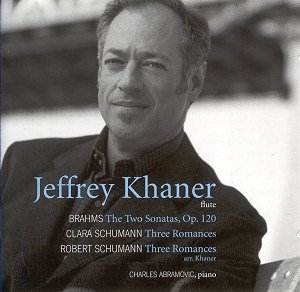This
CD is the fourth in an occasional series for Avie by the
distinguished Canadian flautist Jeffrey Khaner. This one
is in many ways the most interesting and, for me, the most
challenging of the four.
There
is no doubting the brilliance of Khaner’s playing or the
sensitivity of his musicianship. This is to be expected
from a musician who has risen to the dizzy heights of principal
flute in the Philadelphia Orchestra no less, and whose previous
recordings have received pretty much universal plaudits.
The issue here is one of repertoire; while he chose works
originally composed for the flute, some celebrated, some
less familiar, in his other recordings, here he performs
his own arrangements of music by composers who, in Julian
Haylock’s words in the booklet, “are notable for never having
written a single note of solo or chamber flute music.” Well,
that’s up-front anyway!
The
important question is: do they work? The two Brahms
sonatas are central mainstays of the clarinet repertoire
although Brahms also arranged them for viola. Clara Schumann’s
Romances were conceived for the violin of
Joachim, while Robert Schumann’s Romances are most
often heard on the oboe - all with important piano
parts, of course. In some ways, I am uncomfortably aware
writing this review that my familiarity with the Brahms
and R. Schumann items in their original forms makes it doubly
hard for me to approach these versions straightforwardly;
a more valuable review might come from someone with no prior
knowledge of the music.
Changing
the solo instrument inevitably alters the impact of the
music very radically, especially when the two instruments
concerned are as different as flute and clarinet. That might
seem an odd statement when they are both woodwind. Yet the
clarinet has a certain darkness, a complexity of character
that is wholly different from the ingenuous yet incredibly
sensuous voice of the flute. Playing a few bars of the finale
of the Brahms F minor Sonata (track 4) to a clarinettist
friend who knows this music back to front as well as inside
out, it nevertheless took him fully a minute to identify
the piece – which he finally did with some outrage, it has
to be said!
In
fact, I felt that this first of the two Brahms works was
the least successful on the disc; the brooding, dramatic
nature of the first movement in particular seemed frankly
unsuited to the flute’s temperament, well played and arranged
though it is. However, the second sonata is a very different
kettle of fish, and right from its blithe opening melody,
played with insouciant beauty by Khaner, I thoroughly enjoyed
and responded to the music. Even here, though, I was aware
that Brahms has written so much very smooth legato music
in the solo part, long winding lines that are inherently
more natural to the clarinet than the flute.
The
Schumanns, Clara and Robert, probably fare rather better
in this context, mainly because the pieces by which they
are represented are lighter in character than the Brahms
sonatas. What is fascinating – and again this is pointed
out by Julian Haylock – is how very much like her husband’s
music Clara’s Romances do sound. Yet, and this is
equally significant, there is also no way they could actually
be mistaken for Robert’s. They have a charm, a sense of
line that is entirely Clara’s own, and the piano parts are
a joy, having a natural feeling for the piano that is never
quite there in her husband’s more contrived textures. But
I nonetheless urge you to listen to the second of Clara’s
Romances (track 9) followed immediately by the first
of Robert’s (track 11); the resemblance is striking.
Anyway,
despite the rather hair-splitting issues I’ve outlined above,
I enjoyed this disc enormously. At the very least, it’s
an essay in transcription which is of great interest to
woodwind players. And the sheer quality of Khaner’s playing
– technical problems on the whole simply do not arise, curse
the man! – plus his empathetic partnership with the excellent
Charles Abramovic ensure that the CD is full of musical
delights, both for the connoisseur and for the music-lover
who enjoys the sound of this most beguiling of instruments
played by a master. The recording, overseen by producer
and engineer Da-Hong Seetoo, is first class.
Gwyn
Parry-Jones


